
Filling the Emotional Toolbox
January 2021 | by Dustin Lehman, MS, LCPC, LMFT at Northwest Counseling Center
Preparing our kids for life in the world really begins and ends with their forming an identity. This is the primary determining factor of success or failure with respect to their futures. Terry Hargrave, Ph.D., describes that we form an identity by answering two questions: "Who am I?" and "Am I safe?" These answers are found through validations or violations and often determine the reactions or responses we observe in our kids. Parents who take on this role seriously know that identity and our understanding and knowledge of ourselves, and how we understand our personality and skills/talents are found in relationships. The parent-child relationship carries such an intimate and immediate influence on the formation of our kid's identities.
I love that Terry says, "We do not reflect ourselves; rather, we see ourselves and learn about ourselves within the context and reflection of relationships." (Hargrave, T. D., & Pfitzer, F. (2011). Restoration Therapy Understanding and Guiding Healing in Marriage and Family Therapy. Hoboken: Taylor & Francis.). We mirror others. We find comfort in their reflections of us.
One of my favorite examples to share is of a time that I found myself at a stoplight and two ladies crossed in front of me in the crosswalk. I noticed something particularly strange as I watched them walk. Every bit of their movements was in perfect unity: their leg and arm movements were perfectly timed, their stride was equal, and each rise and fall as they stepped were complete and matched. I thought to myself, "They didn't mean to do that" but it's certainly true--we are built for unity and this is particularly evident with our children. My 2-year-old son is a great example of this. When I'm playing my guitar, he wants to do it with me. He mimics my movements and becomes frustrated when his efforts do not match mine. This...is...good. His frustration means he's learning and is generating motivation to continue on towards proficiency.
Now he's extended his desire and motivation by regularly asking for his own guitar, "I want my 'tar. Where's my 'tar?" (Don't worry; Santa is bringing him one for Christmas!)
The big idea then would be:
- To model and create safe scenarios for our kids to see us perform, then
- Invite their participation to engage with us, and
- Encourage their autonomy or differentiation to exercise their independence separate from our participation.
Our kids come into the world fully dependent on our giving, and these moments are necessary. Without them, our children are left to discover and prepare on their own, and while they may find some success, we also see great pain and destructive behaviors that occur from the absence of these modeled experiences. I encourage parents (and regularly remind myself) to pursue their children daily, appropriately invite them into their spaces, and validate successes and build them up in failures.
If our kids see us come home from work and simply sit down at the TV or stare at our phone with a drink in our hand, what is the message? What are we modeling? We all need to belong; we NEED to be kneaded, and this can only be accomplished in relationships. My wife is a Labor and Delivery Nurse, and she told me once that babies need boundaries immediately after they're born. In fact, they search for boundaries with their little arms and legs and cry when they feel insecure or in the absence of boundaries. When we utilize our immediate influence and intimate space with our kids, we're creating opportunities for them to learn about themselves within healthy boundaries. You can do this. They need us to.
Model >>> Engage >>> Exercise Independence
Originally printed in the January 2021 issue of Simply Local Magazine
Never miss an issue, check out SLM's digital editions here!





